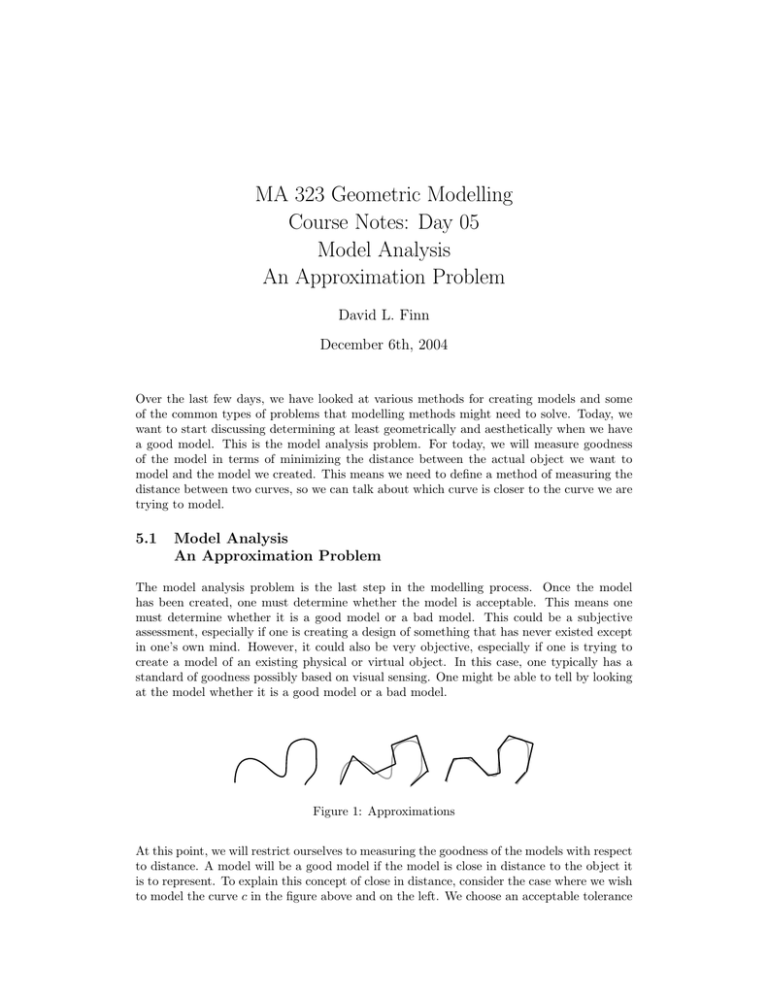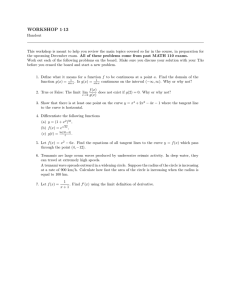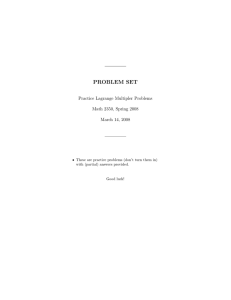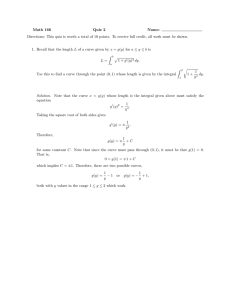MA 323 Geometric Modelling Course Notes: Day 05 Model Analysis An Approximation Problem
advertisement

MA 323 Geometric Modelling
Course Notes: Day 05
Model Analysis
An Approximation Problem
David L. Finn
December 6th, 2004
Over the last few days, we have looked at various methods for creating models and some
of the common types of problems that modelling methods might need to solve. Today, we
want to start discussing determining at least geometrically and aesthetically when we have
a good model. This is the model analysis problem. For today, we will measure goodness
of the model in terms of minimizing the distance between the actual object we want to
model and the model we created. This means we need to define a method of measuring the
distance between two curves, so we can talk about which curve is closer to the curve we are
trying to model.
5.1
Model Analysis
An Approximation Problem
The model analysis problem is the last step in the modelling process. Once the model
has been created, one must determine whether the model is acceptable. This means one
must determine whether it is a good model or a bad model. This could be a subjective
assessment, especially if one is creating a design of something that has never existed except
in one’s own mind. However, it could also be very objective, especially if one is trying to
create a model of an existing physical or virtual object. In this case, one typically has a
standard of goodness possibly based on visual sensing. One might be able to tell by looking
at the model whether it is a good model or a bad model.
Figure 1: Approximations
At this point, we will restrict ourselves to measuring the goodness of the models with respect
to distance. A model will be a good model if the model is close in distance to the object it
is to represent. To explain this concept of close in distance, consider the case where we wish
to model the curve c in the figure above and on the left. We choose an acceptable tolerance
5-2
² > 0. We consider the model to be good if the distance between the model and the curve is
less than ², see diagrams above. From the diagrams above, it is easy to tell that the model
on the far right is the better of the two provided. The question, we want to answer is it
within the acceptable tolerance.
Determining precisely whether a curve is within an acceptable tolerance is intuitively very
simple but hard to calculate. However, we need some terminology from analysis and topology
to state these concepts in a rigorous mathematical form. A neighborhood about the curve
c is formed by considering the set N² (c) formed from the union of the interiors of circles of
radius ² with centers on c, see diagram below. In mathematical terms, the set N² (c) is given
as
N² (c) = ∪t∈[0,1] {(x, y) : (x − ζ(t))2 + (y − η(t))2 < ²}
where c is parameterized over the interval [0, 1] and given by x = ζ(t), y = η(t), see the
diagram below on the right. For a model to be good, it is necessary that the model lie
entirely within a neighborhood of acceptable tolerance, the neighborhood N² (c). Moreover,
the curve modelled must lie within a neighborhood of acceptable tolerance of the model.
Figure 2: A Neighborhood of a Curve
The concept of the distance between two parametric curves is closely related to the concept
of neighborhoods. We define the distance between two parametric curves α(t) and β(s)
using a maximin argument. Recall, the distance between a point and a curve is determine
by finding the minimum distance between the point and a point on the curve. Thus, we
can define a function dα,β (t) to be the distance between the point α(t) and the curve β.
The curve α lies within an ² neighborhood of the curve β if ² > dα,β (t) for all t. Therefore,
we say the distance from α to β is then the maximum of dα,β (t). Similarly, we can define
dβ,α (s) to be the distance between the point β(s) and the curve α, then the curve β lies
within an ² neighborhood of the curve α if ² > maxs dβ,α (s). The distance from β to α is
then the maximum of dβ,α (s).
Figure 3: Distance from One Curve to Another Curve
5-3
It is worth noting that the distance from α to β is not necessarily equal to the distance from
β to α. This is a general property of the max-min arguments,
max(min kα(t) − β(s)k) 6= max(min kα(s) − β(t)k)
t
s
t
s
One can define the distance between the two curves in a symmetric manner, by considering
dist(α, β) = max(dα,β , dβ,α )
With this concept of distance, we have for any ² > dist(α, β) we have α within N² (β) and
β within N² (α).
This is just one manner of measuring closeness. In the geometric modelling, this is a coarse
measure of closeness. For instance, in approximating a circle (see figure below), one can
have a piecewise linear approximation given by interpolation from data points closer than a
“drawn” circle. However, one can easily argue that the “drawn” circle is a better model of
a circle because it appears smoother than the piecewise linear interpolant, see figure below.
Figure 4: Comparing Two Models of a Circle
In the figure above, one can argue that a problem with the “drawn” circle could be the
placement of the circle when calculating the distance. If the circle is moved slightly to the left
in the figure on the right, then the “drawn circle” could be better than the piecewise linear
interpolant. The measure of closeness presented above depends on the relative positions of
the two objects. Technically, in comparing the models one has to minimized with respect
not only to points but also the orientations of the objects, as these will affect the distance.
In fact, this measure of closeness assumes that either physically of virtually the objects can
be placed on top of each other to calculate the distance.
5.2
Better Measures of Closeness
To get a better notion of closeness requires more sophisticated mathematical description
of the model, which we will discuss in more detail when we discuss more sophisticated
modelling techniques. For the moment, we want to discuss briefly what better notions of
closeness would entail.
The measure of closeness presented above is closeness in distance. As mentioned above, it
is possible to have a curve close in distance but not a good model, see diagram below. The
breakdown of this measure of closeness as given by the diagram below is in terms of wildly
oscillating approximation that stays close to the circle. In terms of distance, one would have
5-4
to say this is a good approximation. However, it does not portray the smoothness of the
circle. The tangent lines of the approximating curve do not accurately reflect the tangents
of the point on the circle. A better approximation would have the tangents agreeing also.
Figure 5: Example of a Model Close in Distance, but Not a Necessarily Good Model
The approximation in closeness in distance is in a sense like saying two functions have
approximately the same value at a point. So they are close. This is similar to the use of
the sandwich lemma from Calculus I to say two function have the limit. However, these
arguments say nothing about the existence of a derivative at the point. For that, we have
to do more work. The better measures of distance take into account measures of whether
the curves are not only close in distance but also close in tangency.
There are gradations of closeness. Closeness in distance is the coarsest measure of closeness.
The next level is closeness in distance and tangency. The next level of closeness needs to
compare the second derivatives of the curves or the curvature of the curve at each point.
For each derivative, there is a corresponding notion of closeness. We will not go beyond
second order closeness in our considerations. But, you need to be aware of other measures
of closeness.
In particular, all of the measures mentioned so far are pointwise notions of closeness. None
of them consider whether or not the models have the same length or size. For instance, one
could argue that the model of the circle in Figure 5 is bad not only because of the tangents
are bad, but because the length of the curves are wildly different. To define these more
accurate measures of closeness requires considering the calculus of parametric curves and
other notions of distance.
Exercies
1. Calculate the distance between the circle α(t) = [cos(t), sin(t)] with 0 ≤ t ≤ 2π and a
wavy circle β(s) = [(1 + 0.1 sin(3s)) cos(s), (1 + 0.1 sin(3s)) sin(s)] with 0 ≤ s ≤ 2π.
2. Calculus the distance between the line segment [0, t] with 0 ≤ t ≤ 1 and the parabola
[s2 + s + 1, (4s − 1)/2] with 0 ≤ s ≤ 1.
5-5
3. Write the word ROSE in lower-case script letters.
(a) What is the minimum nunmber of points you need to obtain a reasonable approximation of the letter R using piecewise linear curves?
(b) How many points do you need to get a good approximation of the letter R using
piecewise linear curves?
(c) Approximate the word ROSE using piecewise linear curves and roughly 5 points
per letter. How good of an approximation do you get?
4. Write the word MATH in lower-case script letters.
(a) Approximate the letter M using a nonsmooth piecewise circular curve. How many
points did you use? How did you decide which points to use?
(b) Approximate the letter M using a smooth piecewise circular curve. How many
points did you use? How did you decide which points to use?
(c) Approximate the word MATH using piecewise circular curves and roughly 5
points per letter. How good of an approximation do you get?
5. Write your initials using both piecewise linear curves and piecewise circular curves.
Which is the better aproximation to your initials?







